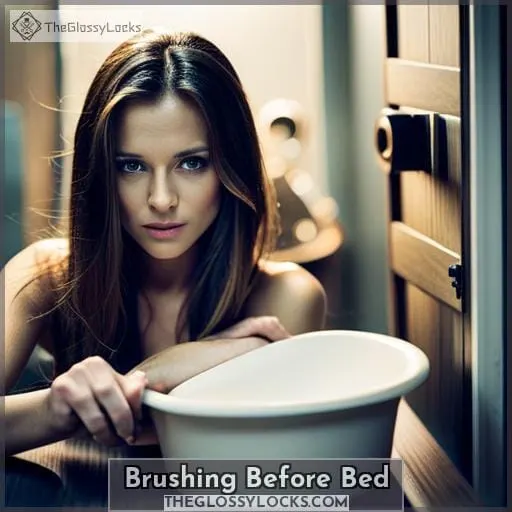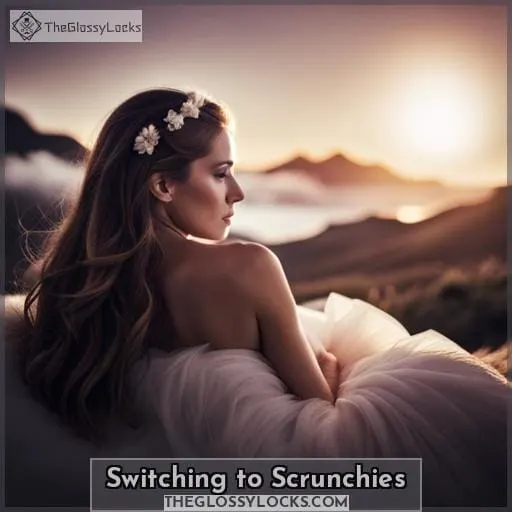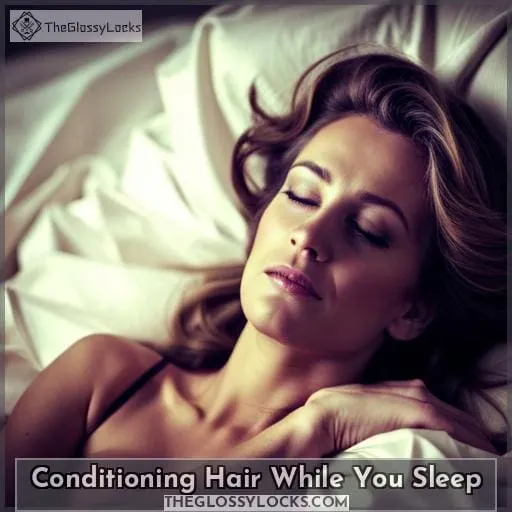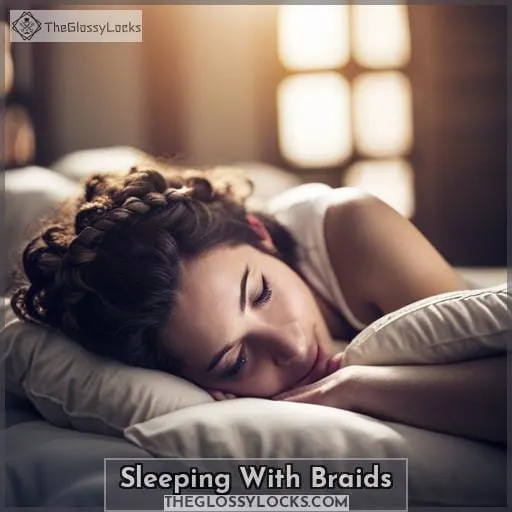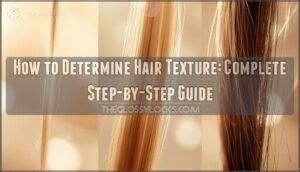This site is supported by our readers. We may earn a commission, at no cost to you, if you purchase through links.
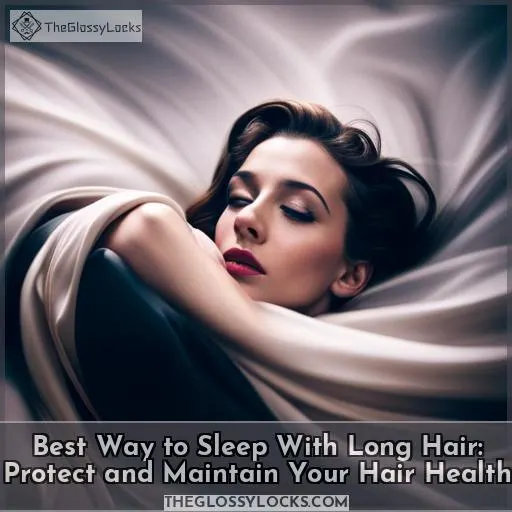
By following simple strategies like using silk or satin pillowcases, timing your showers properly, and wrapping your hair in a scarf or wrap before bed, you can protect your locks from breakage and keep them looking fabulous.
Learn how to brush before bedtime, switch to scrunchies for less damage, use essential oils for protection, condition while you sleep,and create a hair-friendly bedroom environment.
Table Of Contents
- Key Takeaways
- Silk or Satin Pillowcase
- Timing Your Showers
- Scarf or Wrap
- Brushing Before Bed
- Switching to Scrunchies
- Protecting Ends With Essential Oils
- Conditioning Hair While You Sleep
- Sleeping With Braids
- Using Hair Serum or Hair Mask
- Bedroom Environment and Hair Protection
- Frequently Asked Questions (FAQs)
- Conclusion
Key Takeaways
- Use silk or satin pillowcases
- Sleep with braids
- Brush hair before bed
- Protect ends with essential oils
Silk or Satin Pillowcase
When it comes to protecting and maintaining the health of your long hair while you sleep, choosing the right pillowcase is key.
Silk or satin pillowcases offer numerous benefits for your hair.
They reduce friction, preventing stress, frizz, and breakage.
Additionally, silk and satin are hypoallergenic and provide a cooler sleeping surface compared to cotton.
Benefits of Silk or Satin
Sleeping with long hair can be a challenge, but one simple solution that offers numerous benefits is using a silk or satin pillowcase.
The Benefits of Silk or Satin include:
- Preventing hair breakage
- Frizz prevention
- Moisture retention
Choosing the right pillowcase made from silk or satin reduces friction on your hair while you sleep, protecting it from stress and damage. This hypoallergenic fabric also helps prevent skin wrinkles caused by aging and provides a cooling sensation for added comfort during the night.
How to Choose the Right Pillowcase
Looking for the perfect pillowcase to protect your long hair while you sleep? Choosing the right pillowcase is essential for maintaining your hair’s health and preventing damage. Silk or satin pillowcases are highly recommended due to their smooth texture, which reduces friction and prevents frizz and breakage.
When selecting a pillowcase, consider factors such as material quality, thread count, and closure type for optimal results in protecting your precious locks.
| Choosing Pillowcase | |
|---|---|
| 1 | Material Quality |
| 2 | Thread Count |
| 3 | Closure Type |
By considering these factors when choosing a silk or satin pillowcase, you can ensure that your long hair remains protected during sleep while enjoying its many benefits like reduced friction on the strands leading to less stress-induced breakage.
Timing Your Showers
To ensure the health and integrity of your long hair while you sleep, it’s important to time your showers appropriately.
Avoid going to bed with wet hair as it’s more prone to tangling and breakage.
Schedule your hair washing well in advance of bedtime, allowing ample time for your hair to dry completely or blow-dry before getting into bed.
Additionally, finishing showers with a cold water rinse can help seal moisture in the hair, preventing excessive drying or damage overnight.
Why Wet Hair Should Be Avoided
To maintain the health of your long hair, it’s important to avoid sleeping with wet hair.
Wet hair at night increases the risk of:
- Tangling
- Breakage
- Scalp problems
- Odors
It can also lead to illness.
Instead of going to bed with wet hair, try scheduling your showers well in advance of bedtime so that your hair has enough time to dry completely.
If you’re in a hurry and need to protect wet hair from breakage overnight, consider using coconut oil as a protective barrier before sleep.
Best Time to Wash Your Hair
When it comes to maintaining the health and integrity of your long hair, timing your showers is crucial.
The best time to wash your hair depends on various factors such as personal preference, schedule, and lifestyle.
Ideally, it’s recommended to avoid going to bed with wet hair as this can lead to tangling and breakage.
It’s advisable to schedule your hair washing well in advance of bedtime so that you have enough time for drying or styling before sleep.
Additionally, finishing showers with a cold water rinse can help seal moisture in the hair follicles while blow-drying beforehand ensures tangle-free locks throughout the night.
Scarf or Wrap
When it comes to protecting your long hair while you sleep, using a scarf or wrap is an effective method.
Wrapping your hair properly with a silk or satin scarf helps prevent denting and crushing of the hair during sleep.
Additionally, the use of a scarf or wrap protects your hair from humidity and sweat, maintaining its health and preventing frizz.
How to Wrap Your Hair Properly
To properly wrap your hair with a scarf or wrap, use a wide and long satin or silk accessory to ensure maximum coverage and protection.
Start by brushing your hair to remove any tangles or knots before bed.
Then, gather all of your hair at the nape of your neck and secure it with an elastic band.
Next, take the scarf or wrap and place it over your head, making sure to cover all of your hair completely.
Tie it securely in place using a knot at the front or back of your head.
This will help prevent friction and protect against breakage while you sleep.
Benefits of Using a Scarf or Wrap
Now that you know how to properly wrap your hair before bed, let’s explore the benefits of using a scarf or wrap.
Using a scarf or wrap is an effective way to protect your hair while you sleep. It helps prevent frizz, maintains moisture in your hair, and offers protection against breakage.
By covering your hair with a silk or satin scarf or wrap, you create a barrier that reduces friction and keeps your strands smooth and healthy throughout the night.
Incorporating this simple step into your bedtime routine can greatly improve the overall health of your hair.
Brushing Before Bed
Before you settle into bed, it’s important to give your long hair a thorough brushing.
Brushing before bed helps to remove tangles and knots that may have formed throughout the day, preventing them from becoming worse overnight.
It also helps distribute natural oils from the scalp to the ends of your hair, promoting healthier-looking locks in the morning.
Choose a brush specifically designed for long hair, such as one with wide-toothed bristles or a paddle brush, for optimal results while minimizing damage and breakage.
Importance of Brushing
Brushing your hair before bed is an essential step in maintaining the health and integrity of your long locks. By taking just a few minutes each night for this simple task, you can significantly improve not only how well-rested you feel but also how well-groomed those luscious strands look come morning.
When it comes to pillowcase benefits alone, there are several reasons why adding pre-sleep brush sessions into our nightly routines should be non-negotiables:
- Prevent Tangles: Brushing removes any knots or snarls that may have formed throughout the day due mostly because of environmental factors like wind exposure.
- Promote Blood Circulation: Brushing stimulates blood circulation on our scalps which aids nutrient-rich oxygenation necessary for optimal follicle performance (i.
- Distribute Natural Oils: The act itself spreads sebum produced by oil glands located near roots onto strands/ends thus moisturizing them naturally without requiring additional product application such as leave-in conditioner sprays/mists.
- Reduce Hair Loss Potentialities: Regularly removing loose hairs during these sessions prevents accumulation over time thereby lessening chances experiencing excess shedding due largely caused when they intertwine themselves otherwise get trapped within tangled messes overnight causing unnecessary frictional stress leading eventually even more significant consequences like irreversible breakage.
Experts recommend using a wide-toothed comb or brush with soft bristles for gentle yet effective brushing before bedtime. This helps to minimize damage and breakage, especially for those with long hair prone to tangles.
Additionally, incorporating this habit into your nighttime routine can also serve as a relaxing ritual that promotes stress relief and better sleep quality.
Best Brushes for Long Hair
Choose the best brush for your long hair to keep it healthy and tangle-free before bed.
Brushing before sleep is an important step in maintaining your hair’s health and preventing breakage.
Look for brushes with wide-toothed combs or paddle brushes that can detangle without causing damage.
Avoid using harsh bristles or small, fine-toothed combs that can lead to breakage and traction alopecia.
By selecting the right brush, you can ensure a gentle brushing experience while promoting strong, beautiful hair.
Switching to Scrunchies
When it comes to protecting your long hair while you sleep, switching to scrunchies can offer numerous benefits.
Scrunchies are a great alternative to elastic hairbands as they reduce stress on your hair and scalp, minimizing friction, frizz, and breakage.
Additionally, choosing the right type of scrunchie – such as silk or satin ones – can provide additional advantages for maintaining the health and integrity of your long locks during sleep.
Benefits of Scrunchies
To protect your long hair while you sleep, a great option is switching to scrunchies instead of elastic hairbands.
- Reduced Hair Damage: Unlike elastic bands that can cause breakage and snagging, scrunchies are made with soft fabric that’s gentle on the hair.
- Versatile Styling Options: Scrunchies come in various sizes, colors, and patterns, allowing you to match them with different outfits or create fun hairstyles.
- Nightcare Essential: Tying your hair up with a scrunchie at night helps prevent tangles and frizz by keeping it secure while you sleep.
By making this simple switch in your hairstyling routine, you can enjoy the benefits of using scrunchies for healthier-looking locks during both day and nighttime activities.
Choosing the Right Scrunchies for Your Hair
By switching to scrunchies, you can choose the right one for your hair and protect it while you sleep.
Scrunchies are a hair-friendly alternative to elastic bands that reduce stress on your hair and scalp, preventing friction, frizz, and breakage.
When choosing scrunchies, opt for materials like silk or satin which are gentle on the hair. These materials help maintain moisture levels in the hair and minimize damage caused by tight hairstyles or rough fabrics.
Investing in high-quality scrunchies is an effective way to protect your long locks during sleep.
| Choosing Hair-Friendly Scrunchies | Material | Benefits |
|---|---|---|
| Silk | Gentle on the Hair | Reduces Friction |
| Satin | Helps Maintain Moisture | Minimizes Breakage |
Table: Choosing Hair-Friendly Scrunchie Materials
When selecting scrunchies, consider the following:
Protecting Ends With Essential Oils
To protect and maintain the health of your long hair while you sleep, it’s important to consider using essential oils.
Essential oils such as argan, almond, jojoba, or coconut oil can help guard against damage to your hair ends during sleep.
Applying a small amount of these oils specifically on the ends of your hair can prevent friction and split ends while sealing in moisture and protecting against nighttime wear and tear.
Best Essential Oils for Hair Protection
To protect the ends of your long hair while you sleep, consider using essential oils that are known for their nourishing and protective properties.
Here are some of the best oils for hair protection:
- Argan oil: Rich in antioxidants, it helps repair damaged strands.
- Coconut oil: Provides deep hydration to prevent dryness and breakage.
- Jojoba oil: Mimics the natural sebum produced by our scalp, keeping hair moisturized.
- Almond oil: Nourishes and strengthens the hair shaft to promote overall health.
Incorporating these essential oils into your overnight routine can help maintain strong, luscious locks while you sleep.
How to Apply Essential Oils
Apply essential oils to protect the ends of your hair by gently massaging them onto the tips using your fingertips.
Essential oils such as argan, almond, jojoba, or coconut oil can help prevent friction and split ends while sealing your hair against nighttime wear and tear. These oils provide nourishment and hydration to promote healthy growth while you sleep.
To ensure optimal results, consider pairing this treatment with a silk pillowcase for reduced friction and maintaining bedroom humidity for a comfortable sleep environment that benefits both your hair health and overall well-being.
Conditioning Hair While You Sleep
Now let’s talk about the benefits of conditioning your hair while you sleep and how to choose the right overnight conditioner.
Overnight conditioning can strengthen your hair strands and improve their overall health. By selecting a leave-in conditioner with protein or keratin, you can provide essential nutrients to nourish and repair your hair while you sleep.
Make sure to choose a formula that suits your specific hair type, whether it’s hydrating dry locks or opting for a lighter formula for oily hair.
Benefits of Overnight Conditioning
During the night, you can nourish and strengthen your hair by conditioning it while you sleep.
Benefits of overnight conditioning include:
- Maintaining hair health
- Preventing damage
- Enhancing the effectiveness of your overall hair care routine
By choosing the right products specifically formulated for overnight use, you can provide deep hydration and repair to your strands as you rest.
Overnight conditioning helps replenish moisture, reduce frizz, promote shine and manageability in your long locks without any extra effort during the day.
Choosing the Right Overnight Conditioner
When choosing the right overnight conditioner for conditioning your hair while you sleep, consider your specific hair needs and preferences.
Look for a conditioner that provides deep hydration and nourishment to promote healthy hair growth.
Choose one that suits your hair type, whether it’s dry, damaged, or oily.
Pay attention to the ingredients in the conditioner and opt for natural or organic options whenever possible.
Additionally, consider factors such as scent preference and texture of the product to ensure a pleasant experience during your nighttime hair care routine.
| Factors to Consider | Examples |
|---|---|
| Hair Type | Dry |
| Damaged | |
| Oily |
Hair Concerns Frizz
Texture Preferences Creamy
Scent Preference Floral
Sleeping With Braids
When it comes to sleeping with long hair, braids can be a great option.
Not only do they help prevent tangles and frizz, but they also create beautiful waves or curls in the morning.
To sleep comfortably with braids, choose a braid style that suits your preference and secure them using small scrunchies to keep your hair free from sweat, moisture, and friction during the night.
Different Braid Styles for Sleeping
To protect your long hair while you sleep, continue caring for it by exploring different braid styles that are suitable for sleeping.
Sleeping with braids can help prevent breakage and maintain the health of your hair.
There are various braid styles you can try, such as a loose French braid or two Dutch braids.
These styles keep your hair secure and minimize friction during sleep, reducing the risk of tangles and damage.
Incorporating braids into your nighttime routine is an effective way to provide extra protection for your precious locks.
Steps to Secure Your Braids
Secure your braids at night by using small scrunchies to prevent them from unraveling.
To keep your braids intact and maintain their shape, follow these steps:
- Divide your hair into sections: Separate your hair into smaller sections before braiding to ensure even distribution and a neat appearance.
- Braid tightly but gently: Take each section of hair and braid it tightly, making sure not to pull too hard or cause discomfort on the scalp.
- Secure with small scrunchies: Once you’ve finished braiding each section, use small scrunchies or elastic bands to secure the ends of the braids in place.
By following these steps, you can protect your hairstyle overnight and wake up with beautiful, well-maintained long locks in the morning.
Using Hair Serum or Hair Mask
To protect and maintain the health of your long hair while you sleep, using a hair serum or hair mask can be highly beneficial.
Hair serums help to tame frizz and provide lightweight moisture, while overnight hair masks nourish and repair your locks without making them damp.
When choosing a serum or mask, opt for products with botanical ingredients like peppermint oil or aloe vera, avoiding acidic components and heavy protein additives.
Incorporating these products into your nighttime routine can help keep your long hair healthy and protected during sleep.
Benefits of Hair Serum
Experience the incredible benefits of using hair serum or a hair mask to protect and nourish your long locks while you sleep.
Hair serum provides numerous advantages for nighttime hair care, including taming frizz, adding moisture, and promoting overall hair health.
When choosing a serum type, opt for lightweight formulas that won’t make your hair damp or greasy.
Apply the serum evenly through your strands before bed to enjoy its benefits overnight.
Incorporating this step into your nighttime routine can greatly enhance the health and appearance of your long hair.
Best Hair Masks for Overnight Use
For the best overnight hair care, try using a nourishing hair mask to promote repair and hydration.
Overnight masks are designed to deeply condition your hair while you sleep, providing essential nutrients for overnight hydration and repairing damaged strands. These masks help prevent breakage by strengthening your hair follicles and improving overall hair health.
Incorporating an overnight mask into your bedtime routine can make a significant difference in the appearance and texture of your locks, ensuring that you wake up with beautiful, healthy-looking tresses every morning.
Bedroom Environment and Hair Protection
To protect your long hair while you sleep, it’s important to create a hair-friendly bedroom environment.
One key aspect is maintaining the right humidity level in your room. This can be achieved by using a fan to keep the air moving or considering a humidifier to add moisture.
Ensuring a comfortable and non-sweaty sleep environment will help prevent damage and breakage to your precious locks.
Importance of Bedroom Humidity
Maintaining the proper humidity in your bedroom is essential for protecting and promoting the health of your long hair.
Proper humidity levels can prevent moisture loss from the air, which can lead to dryness and damage to your hair strands. Additionally, maintaining a comfortable sleep environment with optimal humidity can help reduce frizz and static electricity that often accompanies dry air.
By creating a hair-friendly bedroom environment with adequate humidity, you’re taking an important step towards ensuring the well-being of your precious locks.
Benefits of Maintaining Humidity in Your Bedroom
How it Protects Hair Health
- Maintains moisture levels in the air
- Prevents dryness
- Reduces frizz and static electricity
- Minimizes breakage
- Promotes a more comfortable sleep environment
- Protects against damage
Tips for Creating a Hair-Friendly Bedroom
Create a hair-friendly bedroom environment by ensuring proper humidity levels and implementing gentle hair securing techniques while sleeping.
Maintain optimal bedroom humidity to prevent dryness and frizz in your hair. Consider using a humidifier or fan to add moisture or keep the air circulating in your room.
Invest in silk pillowcases, which reduce friction on your hair and minimize breakage.
Use accessories like scarves or wraps made of silk or satin to protect your hair from tangling, crushing, and excess sweat during sleep.
Proper nighttime care is crucial for maintaining healthy long hair.
Frequently Asked Questions (FAQs)
How do silk or satin pillowcases benefit my hair while I sleep?
Silk or satin pillowcases benefit your hair while you sleep by reducing friction, preventing stress, frizz, and breakage.
Hypoallergenic and cooling compared to cotton, they also help prevent skin wrinkles caused by aging.
What is the best timing for showers to ensure healthy hair?
To ensure healthy hair, it’s best to time your showers wisely.
Think of your hair as a delicate plant: showering too close to bedtime can leave it vulnerable overnight.
How can a scarf or wrap protect my hair while I sleep?
A scarf or wrap can protect your hair while you sleep by preventing:
- Denting
- Crushing
- Friction
Opt for silk or satin materials to reduce damage and maintain a straight hairstyle.
Use long bobby pins for added security.
Why is it important to brush my hair before bed?
Brushing your hair before bed is crucial as it:
- Stimulates the scalp
- Distributes natural oils, promoting healthier hair growth.
In fact, studies show that regular brushing can increase blood flow to the scalp by 100%.
What are the benefits of switching to scrunchies for my hair while I sleep?
Switching to scrunchies for your hair while you sleep offers numerous benefits.
They reduce stress on your hair and scalp.
They minimize friction.
They prevent frizz and breakage.
They secure your hair in a top knot for easier morning styling.
Conclusion
To protect and maintain the health of your long hair while sleeping, it’s important to follow simple strategies like:
- Using silk or satin pillowcases
- Timing your showers properly
- Wrapping your hair in a scarf or wrap
Brushing before bed, switching to scrunchies, and using essential oils and overnight conditioners can also help keep your hair looking fabulous.
Additionally, creating a hair-friendly bedroom environment by considering humidity levels can further protect your locks.
By incorporating these practices into your nighttime routine, you can wake up with tangle-free, healthy hair.




